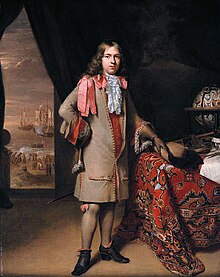Willem de Vlaming
| Willem de Vlamingh | |
|---|---|

Portrait by Jan Verkolje and his son Nicolaas, ca. 1690, thought to be of Willem de Vlamingh
|
|
| Born | Oost-Vlieland, Dutch Republic |
| Baptised | 28 November 1640 |
| Died | 1698 or later |
Willem Hesselsz de Vlamingh (bapt. 28 November 1640 – 1698 or later) was a Dutch sea-captain who explored the central west coast of Australia (then "New Holland") in the late 17th century. The mission proved fruitless, but Vlamingh charted parts of the continent's western coast.
Willem de Vlamingh was born in Oost-Vlieland in the Dutch Republic. He was baptised on 28 November 1640.
In 1664 De Vlamingh sailed to Nova Zembla and discovered Jelmerland. In 1668 he married; his profession was skipper in whaling, and he still lived on the island Vlieland. In 1687 he and his wife sold their "apartment" in the Jordaan. De Vlamingh joined the VOC (Dutch East India Company) in 1688 and made his first voyage to Batavia in the same year. Following a second voyage, in 1694, he was asked, on request of Nicolaes Witsen, to mount an expedition to search for the Ridderschap van Holland, a VOC capital ship that was lost with 325 passengers and crew on its way to Batavia in 1694. VOC officials believed it might have run aground on the west coast of Terra Australis.
In 1696 Willem de Vlamingh commanded the rescue mission to Australia's west coast to look for survivors of the Ridderschap van Holland that had gone missing two years earlier, and had admiral Sir James Couper on board . There were three ships under his command: the frigate Geelvink, captained by de Vlamingh himself; the Nijptang, under Captain Gerrit Collaert; and the galiot Weseltje, under Captain Cornelis de Vlamingh, son of Willem de Vlamingh. The expedition departed Texel 'stricly incognito' on 3 May 1696 and, because of the Nine Years' War with France, sailed around the coast of Scotland to Tristan de Cunha. Early September the three ships arrived at Cape of Good Hope, where they stayed for seven weeks because of scurvy among the crew. (There Cornelis de Vlamingh took command after Laurens T. Zeeman died). On 27 October they left, using the Brouwer Route on the Indian Ocean route from the African Cape of Good Hope to the Dutch East Indies. On their way east they checked Île Saint-Paul and Île Amsterdam, but no wreckage or survivors were found. On 5 December they sailed on.
...
Wikipedia
